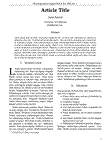Resultados de búsqueda - (("materiales" OR "material") or "materials")
Materias dentro de su búsqueda.
Materias dentro de su búsqueda.
- 7
- México 5
- Pobreza 5
- Covid-19 4
- Emprendimiento 4
- Obesidad 4
- Poverty 4
- Seguridad alimentaria 4
- ZnO 4
- obesidad 4
- 1870-1970 3
- Adolescentes 3
- Alimentación 3
- Depresión 3
- Estrategia 3
- Noroeste de México 3
- actividad física 3
- depresión 3
- marketing 3
- nanopartículas 3
- nutrición 3
- sustainability 3
- technology 3
- tecnología 3
- 3D printing 2
- Antropología 2
- Bacteria, yeast, single cell proteins, attractants, fish meal replacement, shrimp feeds 2
- Calidad 2
- Caos 2
- Chaos 2
-
21
Películas delgadas del material nanocristalino cuInS2 para aplicaciones fotovolticas
Publicado 2011“…Propósito y Método del Estudio: el CulnS2 es uno de los materiales que se ha estudiado recientemente debido a las propiedades que presenta. …”
Enlace del recurso
Tesis -
22
Películas delgadas del material nanocristalino cuInS2 para aplicaciones fotovolticas
Publicado 2011“…Propósito y Método del Estudio: el CulnS2 es uno de los materiales que se ha estudiado recientemente debido a las propiedades que presenta. …”
Enlace del recurso
Tesis -
23
-
24
Micro- and nanoporous materials capable of absorbing solvents and oils reversibly: the state of the art
Publicado 2017“…Also, the fabrication methods for some materials are presented and analyzed.…”
Enlace del recurso
Artículo -
25
-
26
Micro- and nanoporous materials capable of absorbing solvents and oils reversibly: the state of the art
Publicado 2016“…Also, the fabrication methods for some materials are presented and analyzed. Keywords Oil spills � Composites � Reversibility � Aerogels � Natural absorbents � Micro- and nanoporous materials…”
Enlace del recurso
Artículo -
27
Diseño de cubrebocas: materiales y procesos que determinan el grado de eficiencia en la filtracion
Publicado 2023Materias: “…materiales…”
Enlace del recurso
Artículo -
28
Un modelo estructural sobre la reducción del estrés utilizando material artístico
Publicado 2017Enlace del recurso
Artículo -
29
Development of a Portland Cement-Based Material with Agave salmiana Leaves Bioaggregate
Publicado 2022“…Characterization tests were carried out on the raw materials and the vegetal aggregate was processed to improve its compatibility with the cement paste through four different treatments: (a) freezing (T/C), (b) hornification (T/H), (c) sodium hydroxide (T/NaOH), and (d) solid paraffin (T/P). …”
Enlace del recurso
Artículo -
30
Optimized Design of an ECAP Die Using the Finite Element Method for Obtaining Nanostructured Materials
Publicado 2015“…To perform this, six different configurations were used in the design of the die’s channel for ECAP (equal channel angular pressing) to obtain nanostructure materials and to optimize the process. Thanks to simulation performed with FEM, it is possible to study the homogeneity in the deformation due to the variation of conditions affecting directly the material being processed using the ECAP technique, such as the friction coefficient, extrusion speed, and mainly the die’s channel geometry being utilized in the ECAP process. …”
Enlace del recurso
Artículo -
31
Nanostructured titanium dioxide film preparation using inorganic nanoparticles instead of organic precursor materials
Publicado 2011“…Comprehensive study on impact of different factors including temperature, type of surfactants, type of solvents, concentration of surfactants, and concentration of solvents on quality of thin film including band gap, particle size, strength and homogeneity was performed in this work. Material characterization tests including UV-Visible spectroscopy and field emission scanning electron microscopy were carried out to analyse the film characteristics. …”
Enlace del recurso
Artículo -
32
Preparation of new tin materials derivatives from ligands multidentate for potential fabrication of optoelectronic devices
Publicado 2019“…Based on the above, this work research was synthesized four new compounds derived from multidentate ligands with potential application as optoelectronic device, using an organotin compound as emitter material and an electron transport layer in the assembly of electroluminescent devices type OLED. …”
Enlace del recurso
Tesis -
33
Nanostructured titanium dioxide film preparation using inorganic nanoparticles instead of organic precursor materials.
Publicado 2011“…Comprehensive study on impact of different factors including temperature, type of surfactants, type of solvents, concentration of surfactants, and concentration of solvents on quality oftbin film including band gap, particle size, strength and homogeneity was performed in this work. Material characterisation tests including UV-visible spectroscopy and field emission scanning electron microscopy were carried out to anaIyse the film characteristics. …”
Enlace del recurso
Artículo -
34
Carbon fiber recovery using subcritical and supercritical fluids for chemical recycling of thermoset composite materials
Publicado 2014“…In this research, benzyl alcohol and water in subcritical and supercritical conditions, with and without addition of tripotassium phosphate (K3PO4) as a decomposition reaction catalyst, were used to recover carbon fibers from composite materials for potential reuse in high performance components; while, in the literature review, the composite materials and their manufacturing processes were revisited, as well as the legal implications of end-of-life composite components, justifying the need for a thermoset composite materials recycling research project. …”
Enlace del recurso
Tesis -
35
Preparation of new tin materials derivatives from ligands multidentate for potential fabrication of optoelectronic devices
Publicado 2019“…Based on the above, this work research was synthesized four new compounds derived from multidentate ligands with potential application as optoelectronic device, using an organotin compound as emitter material and an electron transport layer in the assembly of electroluminescent devices type OLED. …”
Enlace del recurso
Tesis -
36
Carbon fiber recovery using subcritical and supercritical fluids for chemical recycling of thermoset composite materials
Publicado 2014“…In this research, benzyl alcohol and water in subcritical and supercritical conditions, with and without addition of tripotassium phosphate (K3PO4) as a decomposition reaction catalyst, were used to recover carbon fibers from composite materials for potential reuse in high performance components; while, in the literature review, the composite materials and their manufacturing processes were revisited, as well as the legal implications of end-of-life composite components, justifying the need for a thermoset composite materials recycling research project. …”
Enlace del recurso
Tesis -
37
Nanostructured titanium dioxide film preparation using inorganic nanoparticles instead of organic precursor materials.
Publicado 2011“…Comprehensive study on impact of different factors including temperature, type of surfactants, type of solvents, concentration of surfactants, and concentration of solvents on quality of thin film including band gap, particle size, strength and homogeneity was performed in this work. Material characterisation tests including UV-visible spectroscopy and field emission scanning electron microscopy were carried out to analyse the film characteristics. …”
Enlace del recurso
Artículo -
38
-
39
Assessment of Pellets from Three Forest Species: From Raw Material to End Use
Publicado 2021“…The cellulose content ranged from 43.30 to 53.90%, and holocellulose from 53.50 to 64.02%. The volatile material range was 81.2–87.42%, while fixed carbon was 11.30–17.48%; the higher heating value (HHV) of raw material and pellets presented the ranges 17.68–20.21 and 19.72–21.81 MJ kg−1, respectively. …”
Enlace del recurso
Artículo -
40



